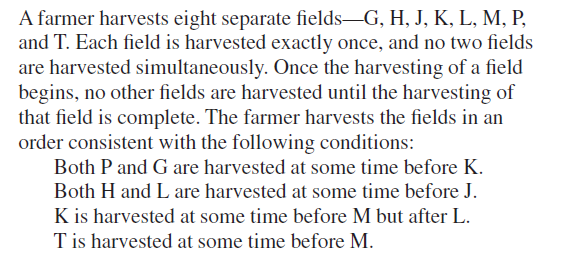
If this can be done the answer choice does not need to be true and so you can cross off this answer choice. To try to disprove (A) place X in the first spot and then try to put Y somewhere other than third that still satisfies all the rules.

It can be false.Įxample: If X is first, which must be true? If you can do this to an answer choice you have disproved that it must be true, or in other words, this answer choice does not have to be true. To disprove an answer choice means to try to place the entities in a different place than what the answer choice tells you and then fill in the diagram without breaking any rules. In a Must be True question you want to try to disprove each answer choice and the one that you cannot disprove is the correct answer choice. Which one of the following entities must be found in a particular place or group?Įach of the following could be false EXCEPT? If …, then which one of the following must be true? Must be True OR Cannot be False OR Could be False Except The only answer left will be your correct answer. If there is more than one answer left when you have applied each rule, apply any rules included in the diagram or the game set up. Then do the same with each successive rule. Take the first rule and apply it to each answer choice, crossing off any which do not work with the rule. When you have applied all of your rules you will be left with only one answer choice. Cross off answer choices that violate the rules. You can use your diagram to answer this type of question, But there is a faster way!Ī great way to approach a “which of the following could be accurate” question is to apply each rule in turn to all of the answer choices. With a little strategy you can improve your speed and accuracy on this question type dramatically. It does not give you any new information about the game and so you must test each answer choice individually to see if it satisfies all of the rules. This question stem is often found in the first or second question. Which of the following could be a complete and accurate list…? Question Stem Explanations and Guide: Complete and Accurate: Then test each answer choice individually. Look to past questions for already completed diagrams that can be re-used. Try to prove that each answer choice could be true, the one that could be true is correct.įill in the extra information into your diagram and try to plug in as many more entities as possible before moving on to the questions. Try to prove that each answer choice could be false, the one that could be false is correct. Try to prove that each answer choice could be true, the one that cannot be true is correct.

Must be False OR Cannot be True OR Could be True Except:

Try to prove that each answer choice could be false, the one that cannot be false is correct. Must be True OR Cannot be False OR Could be False Except: Apply each rule in turn crossing off answer choices that violate rules, OR test each answer choice to see if it could be true.


 0 kommentar(er)
0 kommentar(er)
